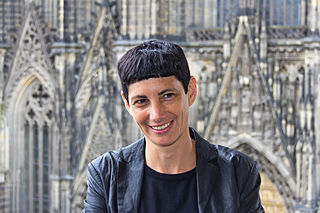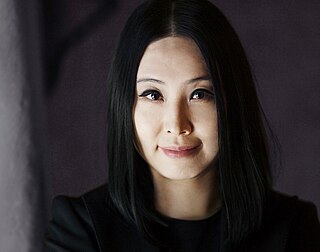
Nam June Paik was a South Korean artist. He worked with a variety of media and is considered to be the founder of video art. He is credited with the first use (1974) of the term "electronic super highway" to describe the future of telecommunications.
Video installation is a contemporary art form that combines video technology with installation art, making use of all aspects of the surrounding environment to affect the audience. Tracing its origins to the birth of video art in the 1970s, it has increased in popularity as digital video production technology has become more readily accessible. Today, video installation is ubiquitous and visible in a range of environments—from galleries and museums to an expanded field that includes site-specific work in urban or industrial landscapes. Popular formats include monitor work, projection, and performance. The only requirements are electricity and darkness.

Doug Aitken is an American multidisciplinary artist. Aitken's body of work ranges from photography, print media, sculpture, and architectural interventions, to narrative films, sound, single and multi-channel video works, installations, and live performance. He currently lives in Venice, California, and New York City.

Trevor Paglen is an American artist, geographer, and author whose work covers mass surveillance and data collection.

The Art Center Nabi (Korean: 아트센터나비) is an art museum in Seorin-dong, Jongno District, Seoul, South Korea. It was relocated to the 4th floor of SK building of SK Group in 2000 and reborn as digital art museum.
The Order of Cultural Merit (Korean: 문화훈장) is one of South Korea's orders of merit. It is awarded by the President of South Korea for "outstanding meritorious services in the fields of culture and art in the interest of promoting the national culture and national development."

Yael Bartana is an Israeli artist, filmmaker and photographer, whose past works have encompassed multiple mediums, including photography, film, video, sound, and installation. Many of her pieces feature political or feminist themes.
The Deutsche Börse Photography Foundation Prize is awarded annually by the Deutsche Börse Photography Foundation and the Photographers' Gallery to a photographer who has made the most significant contribution to the photographic medium in Europe during the past year.
Yongwoo Lee is a South Korean art historian and curator based in Shanghai and Seoul. He is currently a professor at Tongji University and was previously the artistic director of the Shanghai International Art City Research Institute and a professor at the Academy of Fine Arts of Shanghai University.
Haroon Mirza is a British contemporary visual artist, of Pakistani descent. He is best known for sculptural installations that generate audio compositions.

The National Museum of Modern and Contemporary Art, Korea is a contemporary art museum with four branches in Gwacheon, Deoksugung, Seoul and Cheongju. The museum was first established in 1969 as the only national art museum in the country accommodating modern and contemporary art of Korea and international art of different time periods.

Lee Seung-taek is a Korean interdisciplinary artist. He is a sculptor, an installation artist, and a performance artist—conceptualizing in the notion of "anti-concept" or "anti-art" in the Korean art scene.
Gallery Hyundai (Korean: 갤러리현대) is a contemporary art gallery in Seoul, South Korea. It was founded in 1970, initially in Insadong. It moved to Samcheong-ro, Sagan-dong in 1975.

KyungHwa Lee (Korean: 이경화) is a visual art and new media artist, architect, director, and writer exploring the experimental nature of contemporary art from the perspectives of architecture, fashion, and philosophy.

Roh Soh-yeong is a South Korean business executive who is the founder and director of Art Center Nabi.
Sondra Perry is an interdisciplinary artist who works with video, computer-based media, installation, and performance. Perry's work investigates "blackness, black femininity, African American heritage" and the portrayal or representation of black people throughout history, focusing on how blackness influences technology and image making. Perry explores the duality of intelligence and seductiveness in the contexts of black family heritage, black history, and black femininity. "Perry is committed to net neutrality and ideas of collective production and action, using open source software to edit her work and leasing it digitally for use in galleries and classrooms, while also making all her videos available for free online. This principle of open access in Perry's practice aims to privilege black life, to democratize access to art and culture, and to offer a critical platform that differentiates itself from the portrayal of blackness in the media". For Perry, blackness is a technology which creates fissures in systems of surveillance and control and thus creates inefficiency as an opportunity for resistance.
Young In Hong is a visual artist from Seoul, Korea, based in Bristol, England. Hong graduated with an MA and a PhD in Art from Goldsmith College in London UK in 2012. From 1992 to 1998, she studied Sculpture at Seoul National University. Hong currently works from her studio at Spike Island in Bristol and is represented by PKM Gallery in Seoul. She teaches at Bath School of Art as Reader in Performance and Textiles.
Kim Tschang-yeul was a South Korean artist known for his abstract paintings of water droplets. He formed part of the Modern Artists' Association (현대미술가협회) in South Korea and joined the Art Informel movement of the 1950s and 60s. From the late 1960s, Kim Tschang-yeul presented works in international stages, studied in the United States, and eventually relocated to Paris in 1969, where he developed his signature water droplet paintings.
Vakki (Korean: 빠키) is a South Korean artist who runs "Papapapa Tamguso". Based on visual art, it is exploring various media such as stereoscopic installation, spatial art, and video work. Vakki is actively showing exhibitions at the National Museum of Modern and Contemporary Art, Paik Nam-joon Art Center, Daelim Museum's guseulmoa, Seoul Museum of Art, and Arco Art Theater, and many showcases, groups, and individual exhibitions have been held overseas in Berlin, Thailand, and New York. In addition, the field of visual arts is expanding by showing the writer's pleasant visual language through collaboration with cultural and artistic spaces, commercial brands, and fashion designers.
Kim Soun-Gui is a South Korean multimedia artist based in France. Kim was born in Buyeo, South Korea. After graduating from the College of Fine Arts at Seoul National University in 1971, she moved to France to pursue further study in semiology, philosophy, and aesthetics. She began teaching in 1973 as a professor at the École Supérieure des Beaux-Arts in Marseille from 1974 until 2000, and then the Ecole Nationale Superieure d’Art, Dijon from 2001-2011.









